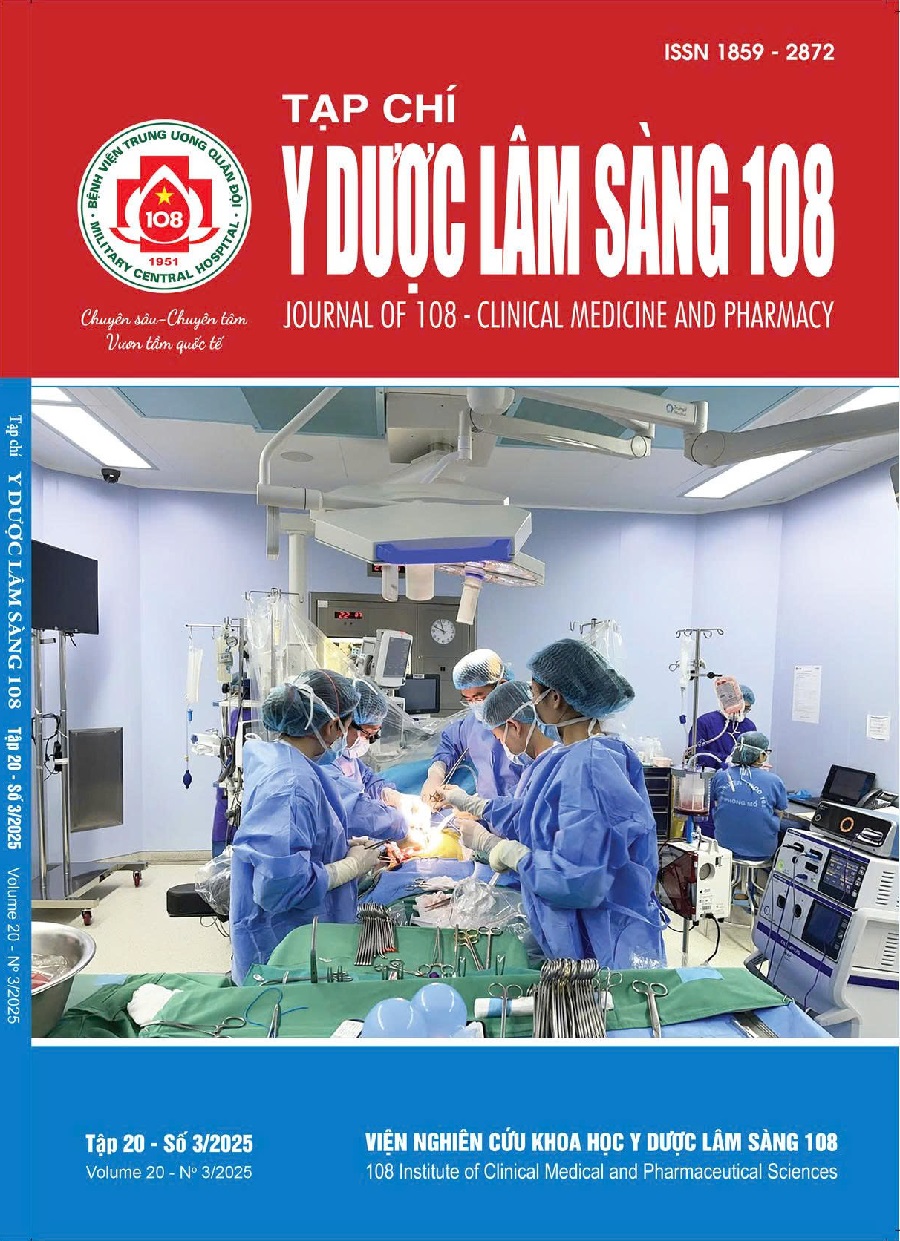Efficacy and safety of biologics in the treatment of inflammatory bowel disease at 108 Military Central Hospital
Main Article Content
Keywords
Abstract
Objective: Biologic agents have been evaluated for their efficacy and safety in patients with moderate to severe inflammatory bowel disease (IBD). However, clinical data in Vietnam remain limited. Therefore, this study aims to assess the safety and treatment response of IBD patients receiving three biologic agents available in Vietnam: infliximab, adalimumab, and ustekinumab. Subject and method: This retrospective study collected data from 91 IBD patients who received biologic therapy at the Department of Gastrointestinal Diseases, 108 Military Central Hospital, from January 2020 to August 2024. Clinical response, clinical remission, and endoscopic remission were assessed at weeks 2 and 14, and at months 6, 12, 18, 24, 36, and 45. Tolerance and adverse effects of biologic agents were also evaluated. Result: Among the 91 patients studied, 71.4% had Crohn’s disease and 28.6% had ulcerative colitis, with a male predominance in both groups. Infliximab was used in 83.5% of patients, adalimumab in 7.7%, and ustekinumab in 8.8%. Most patients achieved clinical remission at weeks 2 and 14 (85–100%). At 12 months, 94% of patients maintained a clinical response to infliximab, with 69% achieving clinical remission and 62.2% achieving endoscopic remission. Five patients experienced grade I/II anaphylaxis during infliximab infusion, four cases of tuberculosis reactivation were observed, three cases of other infection, and one case of Strongyloides infection was recorded. No secondary infections were noted in the eight patients treated with ustekinumab. Conclusion: Infliximab remains the most commonly used biologic therapy for IBD patients, demonstrating rapid symptom improvement and high rates of clinical and endoscopic remission. Preliminary data suggest that ustekinumab is also effective and safe in this patient population.
Article Details
References
2. GBD Inflammatory Bowel Disease Collaborators (2020) The global, regional, and national burden of inflammatory bowel disease in 195 countries and territories, 1990-2017: A systematic analysis for the Global Burden of Disease Study 2017. The lancet. Gastroenterology & hepatology 5(1): 17-30.
3. Chen X, Xiang X, Xia W et al (2023) Evolving trends and burden of inflammatory bowel disease in Asia, 1990–2019: A comprehensive analysis based on the global burden of disease study. Journal of Epidemiology and Global Health 13(4): 725-739.
4. Turner D, Ricciuto A, Lewis A et al (2021) STRIDE-II: an update on the Selecting Therapeutic Targets in Inflammatory Bowel Disease (STRIDE) Initiative of the International Organization for the Study of IBD (IOIBD): determining therapeutic goals for treat-to-target strategies in IBD. Gastroenterology 160(5): 1570-1583.
5. Kim DH, Cheon JH (2017) Pathogenesis of Inflammatory Bowel Disease and Recent Advances in Biologic Therapies. Immune Netw 17(1): 25-40.
6. Nakase H, Uchino M, Shinzaki S et al (2021) Evidence-based clinical practice guidelines for inflammatory bowel disease 2020. J Gastroenterol 56: 489–526.
7. Best WR, Becktel JM, Singleton JW, Kern F Jr (1976) Development of a crohn's disease activity index National Cooperative Crohn's Disease Study. Gastroenterology 70: 439-444.
8. Schroeder KW, Tremaine WJ, Ilstrup DM (1987) Oral 5-ASA therapy for ulcerative colitis. New Engl Med 317(26):1625-1629.
9. Dubois-Camacho K, Ottum PA, Franco-Muñoz D et al (2017) Glucocorticosteroid therapy in IBD. World J Gastroenterol 23(36): 6628-6638.
10. Torres J, Caprioli F, Katsanos KH et al (2016) Predicting outcomes to optimize disease management in inflammatory bowel diseases. J Crohns Colitis 10(12):1385-1394.
11. Vallejo-Yagüe E, Keystone EC, Kandhasamy S et al (2021) Primary and secondary non-response: In need of operational definitions in observational studies. Ann Rheum Dis 80: 961-964.
12. Shah SC, Khalili H, Chen CY et al (2019) Sex‐based differences in the incidence of inflammatory bowel diseases pooled analysis of population‐based studies from the Asia‐Pacific region. Aliment Pharmacol Ther 49(7):904-911.
13. Berg DR, Colombel JF, Ungaro R (2019) The Role of Early Biologic Therapy in Inflammatory Bowel Disease. Inflamm Bowel Dis 25(12):1896-1905.
14. Lee YI, Park Y, Park SJ, Kim TI, Kim WH, Cheon JH (2021) Comparison of long-term outcomes of infliximab versus adalimumab treatment in biologic-naïve patients with ulcerative colitis. Gut Liver 15: 232–242. doi: 10.5009/gnl19433.
15. Colombel JF, Sandborn WJ, Reinisch W et al (2010) SONIC Study Group. Infliximab, azathioprine, or combination therapy for Crohn's disease. N Engl J Med 362(15):1383-1395.
16. Banerjee R, Ali RAR, Wei SC, Adsul S (2020) Biologics for the Management of Inflammatory Bowel Disease: A Review in Tuberculosis-Endemic Countries. Gut and Liver 14(6): 685-698.
17. Click B, Regueiro M (2019) A Practical Guide to the Safety and Monitoring of New IBD Therapies. Inflamm Bowel Dis 25(5):831-842.
 ISSN: 1859 - 2872
ISSN: 1859 - 2872
